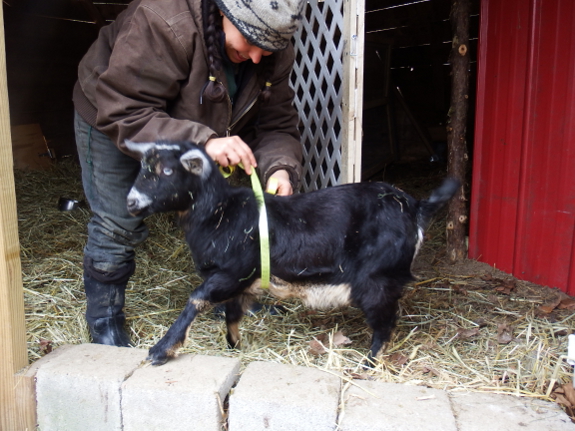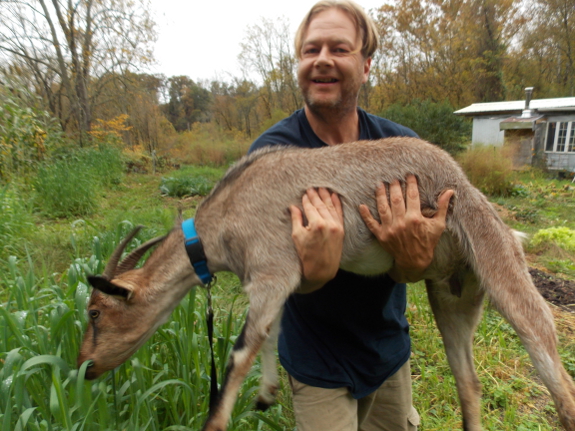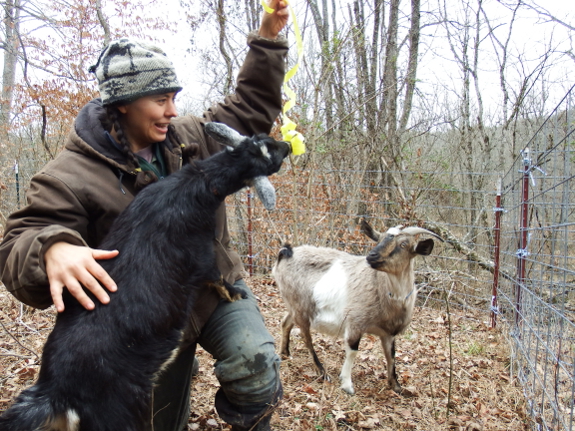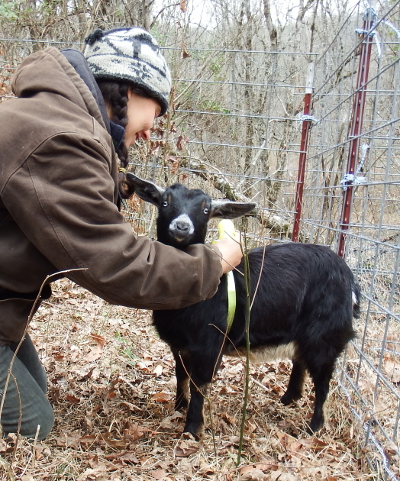
Why and how to estimate a goat's weight

There are quite a few reasons to estimate your goats' weight
on a regular basis. With a doeling, most sources recommend that you
wait to breed her until she's attained 70% of her adult weight, and it's
also handy to keep track of all kids' weight as they grow to make sure
they're doing well.
With adult goats,
frequent weigh-ins help you decipher feeding regimes, medications, and
possible parasite loads. For example, most sources recommend that a goat
be allowed to eat 10% of her body weight in hay if she's not on
pasture. Similarly, you should expect a mature goat to put on a little
weight naturally in the spring when the grass greens up, perhaps to lose
a bit during hot spells in midsummer, then to bulk up a bit again in
the fall. If she's losing weight when she should be gaining, you might
need to focus on deworming.

But it's tough to get an
accurate weight measurement on a goat. First of all, you either need an
animal scale, or you need to pick up the goat (tough for a goat like
Abigail who is not
interested in being manhandled; the photo above comes from this past
fall, when our herd boss was less pregnant and thus less sensitive about
her belly). Similarly, that 10% weight gain after eating her morning
hay is going to completely throw off the measurement.
Enter the goat-girth
chart or the (slightly) more complicated body-weight formula. In the
case of the former (which is accurate to +5%
on standard-sized dairy goats), you measure around the goat's body just
behind their armpits and shoulder blades, then convert from inches to
pounds using the table below. (Be sure to pull the tape tight, and to
take into account fluffy winter hair.) If you want to be more accurate,
you can use the formula right after the chart, which adds in a second
measurement --- the goat's length --- to add in a bit more accuracy.
| Heart girth (inches) | Weight (pounds) | Heart girth (inches) | Weight (pounds) | Heart girth (inches) | Weight (pounds) |
| 10 3/4 | 5 | 20 | 30 | 32 | 100 |
| 11 3/4 | 6 | 21 | 34 | 33 | 105 |
| 12 3/4 | 7 | 22 | 38 | 34 | 115 |
| 13 1/4 | 8 | 23 | 43 | 35 | 125 |
| 13 3/4 | 9 | 24 | 50 | 36 | 140 |
| 14 1/4 | 10 | 25 | 56 | 37 | 150 |
| 14 3/4 | 11 | 26 | 62 | 38 | 160 |
| 15 1/4 | 12 | 27 | 68 | 39 | 170 |
| 16 | 14 | 28 | 73 | 40 | 180 |
| 17 | 16 | 29 | 80 | 41 | 190 |
| 18 | 22 | 30 | 85 | 42 | 200 |
| 19 | 26 | 31 | 90 | 43 | 215 |
Here's the formula: (If you put in inches, then you'll get pounds.)

You can buy tape measurers that automatically convert the heart girth to pounds,
or you can make your own the way I did using a bit of ribbon. While my
ribbon won't be as accurate as using the formula, it should give me an
idea of relative weight gains and losses for our girls, and will
definitely make my life easier since I can just pull it tight around
Artemesia's chest and call out "37 pounds!" (That was my first measurement, but the girls were so  caught
up in enjoying the bright yellow ribbon that they wiggled like crazy
during the first trial. Next time, I'll try measuring while they're
chowing down on breakfast, a period when even Abigail lets me check
beneath her tail, feel under her belly for babies (who kicked
Thursday!), and probe the tendons on either side of her tail to search
for signs of impending birth.)
caught
up in enjoying the bright yellow ribbon that they wiggled like crazy
during the first trial. Next time, I'll try measuring while they're
chowing down on breakfast, a period when even Abigail lets me check
beneath her tail, feel under her belly for babies (who kicked
Thursday!), and probe the tendons on either side of her tail to search
for signs of impending birth.)
Adding this data to my
rough body-condition measurements (feeling for fat in various locations
along the body) should help make sure I feed our girls just enough but
not too much. I'm not sure that Abigail could
eat too much food right now, but since we've decided not to breed
Artemesia at her bare-minimum age, we'll have to be careful that she
doesn't get too fat while waiting for her fall date with a buck
(possibly one of Abigail's kids?). Good thing our little doeling thinks a
measuring tape around her chest is as good as a hug!
Want more in-depth information? Browse through our books.
Or explore more posts by date or by subject.
About us: Anna Hess and Mark Hamilton spent over a decade living self-sufficiently in the mountains of Virginia before moving north to start over from scratch in the foothills of Ohio. They've experimented with permaculture, no-till gardening, trailersteading, home-based microbusinesses and much more, writing about their adventures in both blogs and books.
Want to be notified when new comments are posted on this page? Click on the RSS button after you add a comment to subscribe to the comment feed, or simply check the box beside "email replies to me" while writing your comment.
- Remove comment
